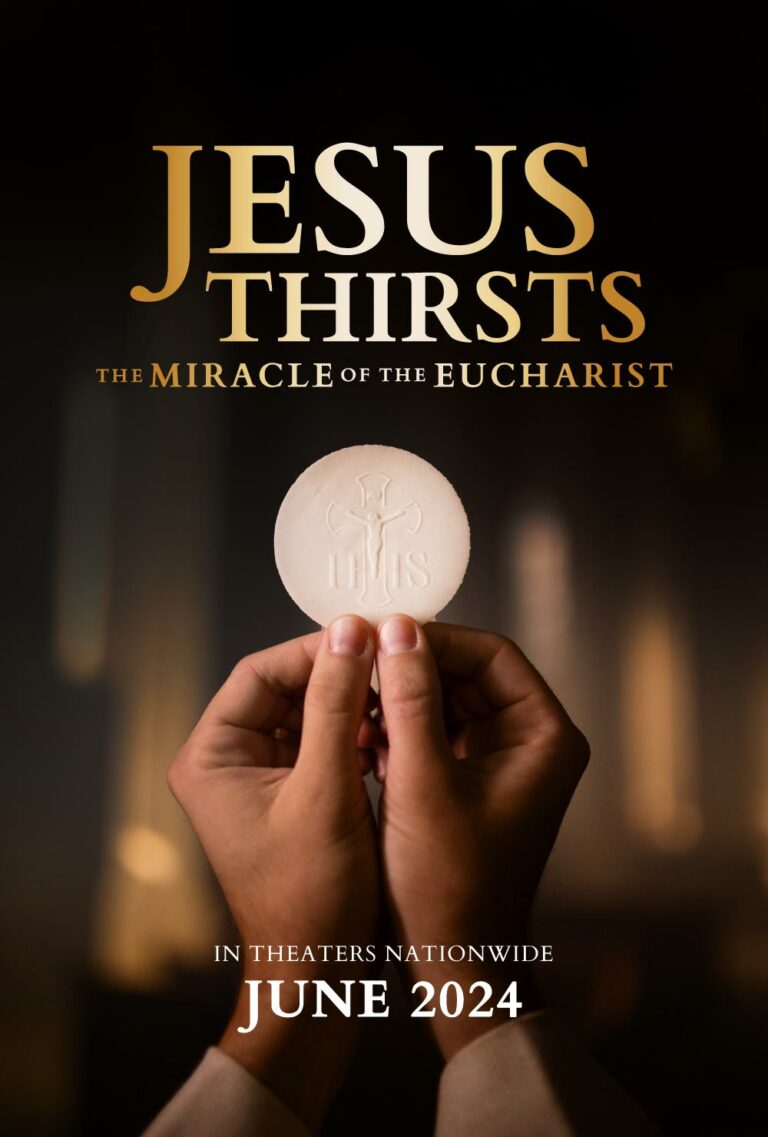“Celebrating the Catholic View of Communion”

| None | Light | Moderate | Heavy | |
|---|---|---|---|---|
| Language | ||||
| Violence | ||||
| Sex | ||||
| Nudity |
What You Need To Know:
JESUS THIRSTS is informative and inspiring, even if you’re not personally a Catholic or Christian. The documentary sees the Catholic Church’s ritual of the Eucharist as a means where people of faith can renew their love for Jesus and find hope, strength, joy, and love. JESUS THIRSTS is not only a celebration of the Eucharist ritual or sacrament as the Catholic Church understands it. It’s also a promotion of the Church itself, and of the Church’s ongoing Eucharistic revival and outreach to the world. JESUS THIRSTS has two references to the Virgin Mary that many Protestants will think takes focus away from Jesus.
Content:
Very strong Christian, biblical worldview from a Roman Catholic perspective of the Eucharist, or Communion, also meant to promote becoming a member of the Catholic Church and to help Catholics increase their faith, their commitment to the Church and their evangelical outreach, and movie promotes a personal relationship with Jesus Christ through participation in the Eucharist ritual and promotes love, mercy, hope, forgiveness, and joy, but an ornate statue/display of the Virgin Mary in one Catholic Church seems a bit gaudy and seems to take focus away from Jesus Christ, and one priest says Mary spiritually brings people to Jesus, plus an anti-communist sequence where Vietnam persecutes and imprisons a Catholic priest for many years;
No foul language;
Brief images of the crucifixion and some newsreel footage of other implied acts of violence;
No sex;
No nudity;
Monks pick grapes to make wine for the Eucharist or Communion, two men taste a batch of the wine the monks made;
No smoking or drugs; and,
Nothing else objectionable.
More Detail:
The movie opens with a citation of John 6:51, where Jesus tells a crowd of listeners, “I am the living bread that came down from Heaven. Whoever eats this bread will live forever.” The movie then movies into a short sermon excerpt from the late Bishop Fulton J. Sheen, a popular Catholic evangelist on the radio in the 1930s and 40s, and a popular televangelist in the 1950s and 60s. In that excerpt, Bishop Sheen notes that each church building, especially, apparently, a Catholic Church, is a “House of God.” There, in the church and on the tabernacle where the Eucharistic bread and wine are placed, the person of faith should perceive “the divinity of Christ.”
The movie then moves on to discuss how vital and foundational the Eucharist, and Jesus Christ’s divinity, are to the Catholic Church and to society in general. However, it notes that, in 2019, a Pew research survey of Roman Catholic congregants found that only one-third of Catholics believe that the bread and wine in the Eucharist are the Body and Blood of Jesus Christ. This finding shocked Catholic leaders into starting a movement to revive Catholic teaching about the Eucharist and the “real presence” of Jesus in the physical elements.
Of course, as many religious scholars and historians know, traditionally, the Anglican, Lutheran, Presbyterian, Episcopal, and Methodist churches teach the “real presence” of Jesus in the Eucharist. However, they have slight differences between one another and with the Catholic Church’s doctrine. Other Christian denominations treat the Eucharist communion ritual as a “memorialization” service. They pick up the words of Jesus at the Lord’s Supper, where Jesus says to perform the Eucharist ritual “in remembrance of me” (see Luke 22:19). They also say that, when Jesus tells the apostles, “This is my body,” he’s using a metaphor, and metaphors are never to be taken literally.
At any rate, the movie explores the biblical origins and meaning of the Eucharist with notable Catholic leaders, including various scholars. It also shares personal stories of people whose lives have been transformed by the Eucharist. Included in those stories are two miracle claims, where real human blood was discovered on a Catholic communion wafer.
Catholic leaders in the movie blame modern-day materialism and secularism for the decline of Catholic belief in the real presence of Jesus in the Eucharist. They stress that in the bread and wine, people of faith are personally encountering the body, blood, soul, and divinity of Jesus. As a result, Jesus becomes part of the person of faith in a real way that gives them spiritual access to his “boundless love” as well as His strength, mercy and joy. By administering the Eucharist, the Catholic priest is also offering himself to the flock.
JESUS THIRSTS is informative and inspiring, even if you’re not personally a Catholic or Christian. The documentary sees the Catholic Church’s ritual of the Eucharist as a means by which people of faith can renew their love for Jesus; find hope, rest and strength; and, discover the power, enlightenment and joys of their own personal vocation in God’s Kingdom. For example, at the end, in another brief sermon excerpt, Bishop Sheen says that, through “the Divine Presence” of Jesus in the Eucharist, he found power, enlightenment and many joys in his particular personal vocation of being a Catholic priest.
One of the most inspiring stories in JESUS THIRSTS is that of a Vietnamese priest. The communist tyrants who took control of Vietnam in the 1970s imprisoned the priest and put him into solitary confinement for many years. The priest, who was eventually released and emigrated to the West, says he found strength and joy during that time by secretly performing the Eucharist for himself and his guards. Miraculously, the priest says he didn’t hate the people who imprisoned him but loved them and forgave them. This is something he felt until his recent death, according to the movie.
JESUS THIRSTS is not only a celebration of the Eucharist ritual or sacrament as the Catholic Church understands it. It’s also a promotion of the Church itself, and of the Church’s ongoing Eucharistic revival and outreach to the world. So, Protestant viewers probably will not approach the movie in the same ways as a Catholic or former Catholic might. Especially since one priest says that the Virgin Mary brings people to Jesus. Also, one scene in JESUS THIRSTS shows an ornate statue of Mary in one Catholic Church that seems a bit too gaudy. Many Protestant believers will think such a statue takes too much focus away from Jesus, the Author and Finisher of their faith.


 - Content:
- Content: 

